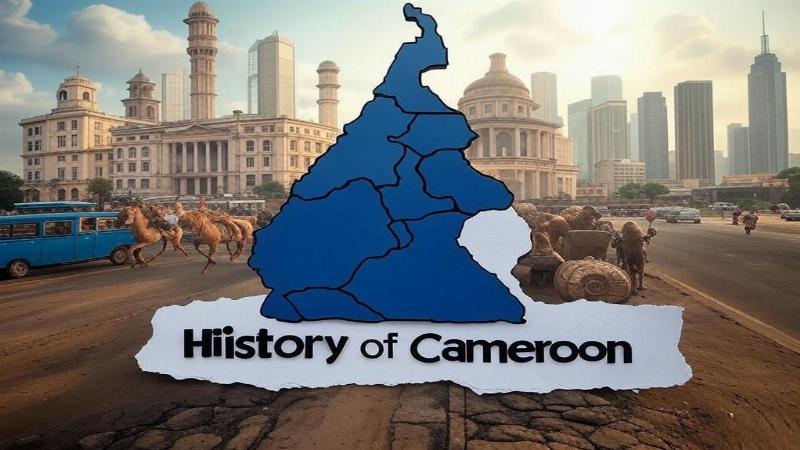Place for ads

Cameroon, a vibrant nation in Central Africa, is a land where rainforests, mountains, and coastlines frame a rich historical tapestry. Covering 475,442 square kilometers, it stretches between Nigeria, Chad, Central African Republic, Equatorial Guinea, Gabon, and the Atlantic Ocean, its diversity mirrored in its people. Known today for its cultural blend, coffee, and Mount Cameroon, Cameroon’s history weaves together ancient civilizations, colonial partitions, and modern resilience. In this article, we’ll journey through Cameroon’s past, from its earliest days to its contemporary identity, uncovering the milestones that have shaped this dynamic country.
Cameroon’s human story begins around 50,000 BCE, with hunter-gatherers roaming its savannas—stone tools from Shum Laka near Bamenda date to 30,000 BCE. These early peoples, likely ancestors of the Pygmy groups like the Baka, thrived in forests, leaving flints and bones as clues to their lives.
By 2000 BCE, Neolithic farmers settled—pottery at Obobogo near Yaoundé shows millet and yam cultivation. Bantu migrations from Nigeria (1000 BCE–500 CE) brought ironworking—smelting sites in the Adamawa Plateau mark their spread. These Bantu, including the Duala and Bamileke, shaped Cameroon’s ethnic core, blending with Pygmies over centuries.
By 500 CE, the
Place for ads
The Sao faded by the 16th century, overtaken by the Kanem-Bornu Empire, which stretched into Cameroon—its cavalry raided for slaves. Coastal Duala and interior Tikar chiefdoms emerged, trading palm oil and ivory with Fulani merchants. These states set the stage for Cameroon’s pre-colonial diversity.
The 15th century saw Portuguese sailors reach Cameroon’s coast—Fernão do Pó named the Wouri River “Rio dos Camarões” (River of Prawns) in 1472, birthing the country’s name. Coastal Duala became middlemen—European guns swapped for slaves and oil, feeding the Atlantic trade. By 1800, over 200,000 captives had left Cameroon’s shores.
Inland, the Bamoun Kingdom under King Njoya (1860–1933) flourished—Bamenda’s palaces and his Shümom script rivaled Europe’s literacy. Fulani jihads from Nigeria hit the north—Sokoto’s influence peaked in the 19th century, converting Adamawa. These powers thrived until Europe’s scramble intervened.
In 1884, Germany claimed Kamerun—Duala chiefs signed treaties with Gustav Nachtigal, ceding trade rights. Douala became the capital—plantations grew cocoa, and railways linked Buea to the coast. Resistance flared—Bamileke and Bassa revolts in the 1890s were crushed, but German rule modernized infrastructure.
World War I ended German control—British and French forces seized Kamerun in 1916. The 1919 Treaty of Versailles split it—France took 80% (East Cameroun), Britain the west (British Cameroons). This division shaped Cameroon’s dual colonial legacy, a fracture still felt today.
French Cameroun, ruled from Yaoundé, pushed cash crops—coffee and rubber drained fields, while schools taught French. Indirect rule via chiefs kept order, but uprisings—like the 1955 UPC rebellion—demanded freedom. The UPC, led by Ruben Um Nyobé, was banned, its leader killed in 1958, fueling unrest.
British Cameroons, split into Northern and Southern zones, lagged—administered from Nigeria, it saw less investment. Southern Cameroons leaned toward union with French Cameroun, while the north eyed Nigeria. Both colonial powers faced growing nationalism—independence loomed.
French Cameroun gained independence on January 1, 1960, as the Republic of Cameroon—Ahmadou Ahidjo, a Fulani Muslim, led with French backing. The UPC insurgency persisted—thousands died until 1970. British Cameroons voted in 1961— the south joined Cameroon, the north Nigeria, forming a federal state.
Ahidjo unified it in 1972, renaming it the United Republic of Cameroon—English and French became official, though tensions simmered. Oil boomed in the 1970s—offshore wells near Limbe funded growth—but Ahidjo’s 1982 exit to Paul Biya sparked a 1984 coup attempt, swiftly crushed.
Biya’s rule—Africa’s longest at 42 years—centralized power—renaming the country simply “Cameroon” in 1984. Oil, timber, and cocoa drive the economy—Douala hums as a port—but corruption and poverty grip 40%. The 1990s saw multiparty democracy—John Fru Ndi’s SDF challenged Biya, yet he endured.
The Anglophone crisis erupted in 2016—Western regions, feeling marginalized, demanded secession as “Ambazonia.” Violence killed 6,000, displaced 700,000—Boko Haram’s northern raids add strain. Today, Cameroon’s 28 million people balance heritage—Fon palaces, Fulani horsemen—with modern woes.
Cameroon’s history is a Central African saga—from Sao clay to colonial chains, unity to unrest. Its rivers whisper of ancient trade, its cities pulse with grit. As Cameroon strides forward, its past fuels a legacy of diversity and defiance.
Place for ads